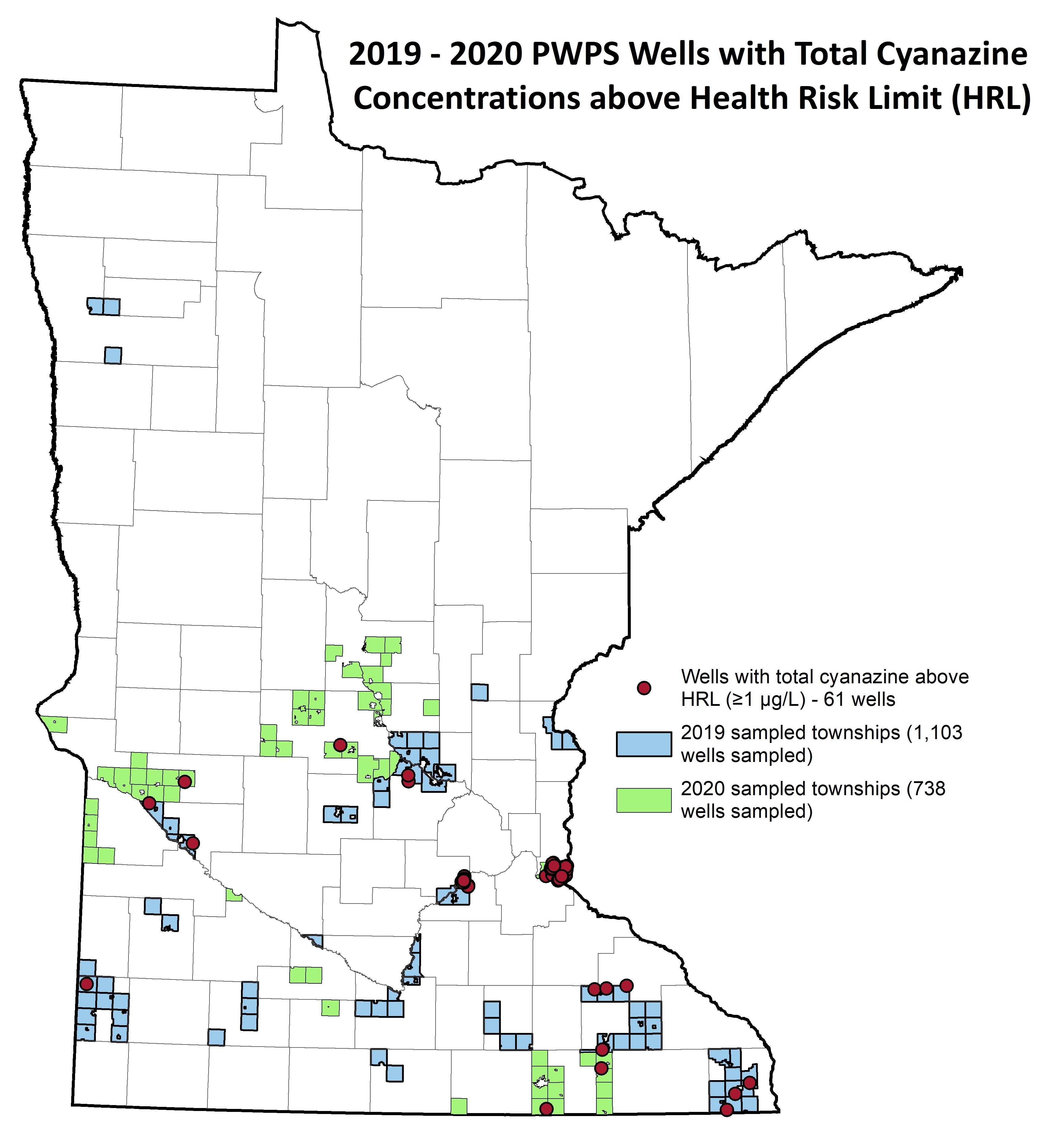Consuming water with concentrations of total cyanazine (cyanazine plus its breakdown products) above the Health Risk Limit (HRL), set by the Minnesota Department of Health (MDH) at 1 microgram per liter (µg/L) or 1 part per billion (ppb), may present a health risk when consumed over long periods of time. Consuming water with total cyanazine concentrations above 3 µg/L may pose a risk if consumed in shorter periods of time. View the MDH Cyanazine in Drinking Water fact sheet for more information on the risks associated with cyanazine and its breakdown products.
Results
The table below shows results for counties that had private well samples with a concentration over the total cyanazine HRL of 1 µg/L in 2019 and 2020. The map below indicates total cyanazine detections greater than 50% of the health reference value from sampling in private wells in 2019.
Summary of cyanazine-related monitoring results, from Private Well Pesticide Sampling Project sampling during 2019-2020, for counties that had concentrations of total cyanazine over the HRL.
| County | Number of Samples | Number of Samples Over the HRL (1 µg/L) |
|---|---|---|
| Chippewa | 46 | 2 |
| Dakota* | 84 | 14 |
| Houston | 151 | 3 |
| Mower | 173 | 2 |
| Olmsted | 123 | 4 |
| Pipestone | 35 | 1 |
| Scott | 91 | 17 |
| Stearns | 244 | 1 |
| Swift | 25 | 2 |
| Washington | 99 | 27 |
| Wright | 180 | 2 |
*Represents resampled wells with previous detections, based upon sampling done by Dakota County Environmental Resources Department.

The MDA is responsible for monitoring groundwater and surface water for pesticides and fertilizers. They also provide support to other agencies that are interested in monitoring for pesticides. As described above, the MDH is responsible for developing health-based reference values for drinking water and monitoring public water supplies. The Minnesota Pollution Control Agency (MPCA) is responsible for developing surface water regulatory standards and monitoring surface waters for non-agricultural chemicals. There are no surface water standards or reference values for the cyanazine breakdown products.
Prior to 2019, only one federal research laboratory in the nation was capable of testing for cyanazine breakdown products. In early 2019, the MDA laboratory and a private laboratory under a contract with the MDA (Weck Labs) were able to develop a method to detect and measure cyanazine breakdown products in water. Both the MDA and the contract laboratory have been conducting analysis for cyanazine breakdown products in water samples since March 2019. Starting in 2021, another private lab (Eurofins Eaton Analytical) is now capable of analyzing for the cyanazine breakdown products, bringing the total private labs to two.
Because cyanazine is no longer used in the U.S., responding to detections of cyanazine breakdown products is generally limited to identifying areas of the state where these compounds may be present in groundwater and assisting the MDH in making recommendations for treatment of drinking water. At this time, the MDA believes concerns related to cyanazine degradates are primarily a groundwater issue, as detections in surface water (rivers and streams) have been limited. The MDA has worked with a commercial laboratory to develop a lower cost option for testing for atrazine, cyanazine and their breakdown products in water samples.
In 2019 and 2020, the MDA included the analysis of cyanazine breakdown products in its groundwater, surface water, and Private Well Pesticide Sampling (PWPS) Project, providing data from monitoring locations throughout the state. In addition, in 2019 the MDA collected samples from 84 private well locations in Dakota County that had previously exhibited detections of cyanazine breakdown products based upon sampling performed by Dakota County Environmental Resources Department using a federal research laboratory. The MDA also evaluated the effectiveness of existing in-home water treatment systems at removing pesticides (including the cyanazine breakdown products) at multiple locations during the year.
Pesticides, including cyanazine breakdown products, may be present in your well water if you are in an area that has historically been used to grow corn and where your groundwater may be vulnerable to contamination. If you are unsure if groundwater in your area is considered vulnerable, you can check the MDA’s interactive Vulnerable Groundwater Area Map.
The cost for testing for pesticides in water may exceed the cost of a point-of-use home treatment system, such as reverse osmosis for drinking water. In sampling conducted by the MDA, water from 54 private drinking water wells was sampled before and after it passed through the homeowners’ reverse osmosis system. The results indicated reverse osmosis home treatment systems removed 99.7 percent of pesticides that were evaluated, including 100 percent of the cyanazine breakdown products. The reverse osmosis systems also reduced nitrate concentrations in the water to levels below the drinking water standard of 10 mg/L. It is important to note that the systems need to be properly maintained.
If considering a treatment system, make sure the treatment unit is certified by the National Sanitation Foundation International (NSF), Underwriter’s Laboratory (UL), or Water Quality Association (WQA) to remove pesticides. View the MDH's Home Water Treatment Fact Sheet for more information about these technologies and grant and loan programs to help pay for treatment.
In 2021, the MDA will continue to monitor for cyanazine breakdown products in groundwater and surface water through the Agricultural Chemical Monitoring and Assessment program, and private wells through the Private Well Pesticide Sampling Project.

